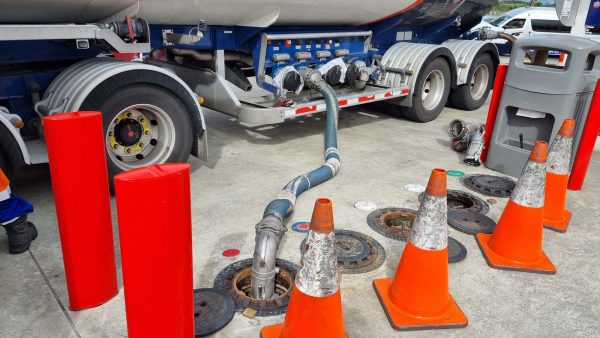The prevention of dangerous goods spillages is one of the most important responsibilities for drivers carrying hazardous materials. A single incident can have severe consequences for public safety, the environment, and your career. Understanding how to prevent spillages requires attention to detail at every stage of the journey.
Before You Start
The foundation of spillage prevention begins before you even start the engine. Thoroughly inspect your vehicle’s containment systems, whether you’re carrying packages, bulk materials, or operating a tanker. Pay particular attention to seals, gaskets, and closure mechanisms. For tankers, check that manholes and discharge valves are properly secured and sealed.

Make sure your load is properly secured against movement. Even minor shifts during transport can compromise containment, especially with packaged goods. Use appropriate load restraint systems and ensure there’s no possibility of packages rubbing against each other or vehicle surfaces during transit.
Understanding Your Load’s Behaviour
Different dangerous goods behave differently during transport. Liquids, for instance, create surge forces that can affect vehicle stability, particularly tankers. When cornering, braking, or accelerating, these forces can be significant enough to compromise vehicle stability if not properly managed. Understanding your load’s characteristics helps you adapt your driving style accordingly.
For tankers, partial loads are often more hazardous than full ones due to the greater possibility of surge. This is why many substances have minimum filling requirements—typically around 80% capacity—to reduce movement. Baffles in tankers help control this movement, but they’re not a complete solution. Your driving technique must still account for load movement.
Rollover prevention training is critical for tanker drivers.
Route Planning and Journey Management
Careful route planning can significantly reduce spillage risks. Consider road conditions, weather forecasts, and potential hazards. Avoid routes with sharp bends where possible, especially when carrying liquids. If you’re carrying temperature-sensitive materials, plan your journey to avoid exposure to extreme conditions that could affect your load’s stability.
During Transit
Regular checks during your journey are essential. ADR regulations require periodic inspections of your load and vehicle during transport. Use these stops to check for any signs of leakage or package deterioration. Pay special attention after driving on rough roads or experiencing severe weather conditions.
Loading and Unloading
Statistics from the Health and Safety Executive show that most dangerous goods incidents occur during loading and unloading operations rather than during transit. When loading, ensure packages are properly sealed and undamaged. For tankers, verify that all valves are in the correct position and that loading rates don’t exceed the tank’s design specifications.
Emergency Response
Despite the best preventive measures, it’s essential to be prepared for spillages. Ensure you’re familiar with your vehicle’s spill control equipment and know how to use it effectively. Your vehicle must carry appropriate personal protective equipment and spillage control materials as specified in ADR regulations.
Remember that your response to a spillage should always prioritise safety over clean-up. If you discover a leak, your first actions should be to ensure your own safety and alert appropriate authorities through your transport manager.
Training and Competence
Regular training is not just a legal requirement – it’s a practical necessity. Technology and best practices evolve, and refreshing your knowledge helps maintain high safety standards. Many operators now provide additional training beyond the minimum ADR requirements, focusing on specific products and equipment they transport.
By maintaining a professional approach to spillage prevention and staying current with best practices, you can significantly reduce the risk of incidents during transport. Remember, prevention is always better than dealing with the consequences of a spillage, both for safety and operational efficiency.
